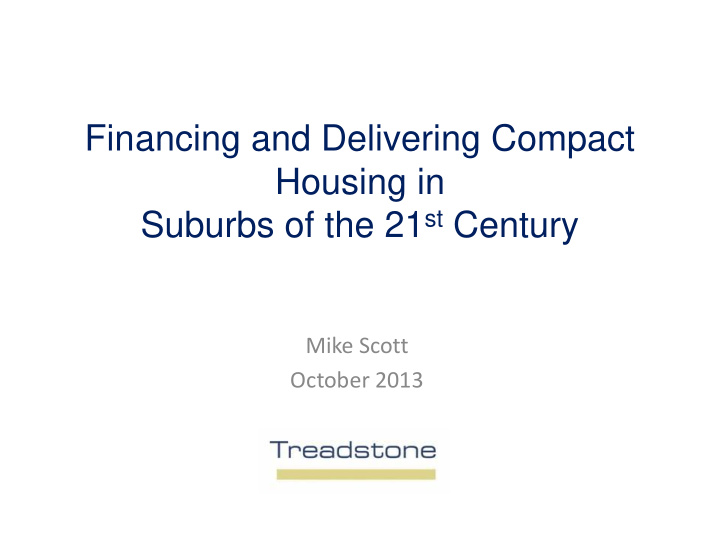



Financing and Delivering Compact Housing in Suburbs of the 21 st Century Mike Scott October 2013
Introduction • NW and SW Growth Centres (case study) • Research for Department (DP&I) – Demand for Diversity – Barriers to more Housing Diversity – Examples of Housing Diversity – Thornton (Demonstration Project) • Delivery and Financing Issues • Summary
The need to access new markets Shrinking Market Growth into New Markets Metropolitan Development Program (MDP) Forecast - DoPI
Growth Centres North West Growth Centre Blacktown CC Example Densities and Yields 12.5 & 15 du/h – 50% (10,380) 20 & 25 du/h – 38% (7,820) 30 + du/h – 12% (2,750)
Industry Research & Issues • Lack of Industry Activity in the Supply Pipeline • Survey, Interviews, Research and Case Study • Growing demand for more diversity and less demand for 450 m2 + • Barriers to increase housing diversity • Examples of projects with more diversity • Recommendations
Demand is changing • In 2013 the Boomers are now between 52 – 67 years old • The Housing Industry has followed the Baby Boomers since late 1970’s • Suburbs since EPA in 1979 lack diversity, built for boomers • Boomers kids should be starting to come through as FHB’s but the last Census showed they are staying at home • Downsizing Boomers, Boomer Kids (FHB’s) and Investors will need to be considered not just Move Up Buyers • Affordability it a big issue when accessing FHB’s and downsizes
Boomers and Boomers Kids
Boomer Bubble in Growth Areas
Household Change
Barriers to Housing Diversity • Historic Controls and Regulations Controls come from historical infill DCP’s for villas, townhouses and RFB’s. Not suited to the new housing types Different across LGA’s • Capital Funding Requirements Housing Industry very mature Industry has lost its attraction to the markets
Integrated v Subdivision • Subdivision and Project Homes Normal Business or Business as Usual (BAU) Land Sale and a Construction Loan (Progress Payments) – very efficient • Integrated Development (now catching 50%) Developer and Builder Role in one additional $50,000 per dwelling (approx $1 million per hectare) Risk - Home Owners Warrantee (HOW) Insurance Funding & Pre-sales (12 months +) Out of date designs
Examples – 20 & 25 du/h • Existing Master-Planned Communities with smaller lots and zero lot detached homes (Council accepted). • Current Examples: Ropes Crossing (Blacktown), Rouse Hill (The Hills), Jordan Springs (Penrith), Georges Fair (Liverpool), Oran Park & Gregory Hills (Camden) and OneMinto (Campbelltown). • Clarendon Ariel 27 on Display at Georges Fair on 300 m2 (10m x 30 m) lot. • Eden Brae Cambridge 22 suits minimum lot sizes down to 225 m2 (9m x 25 m) lot.
Current Examples
Eden Brae - standard design for a 225m2 (9m x 25m) lot Current Examples
House Types – 30 + du/h • Affordability is about quality not just quantity • Thornton – North Penrith • Compact Detached homes on Lots < 225 m2 • Terrace Homes – Abutting v’s Attached • Small Strata Schemes • Studios - Fonzie Flats • Cottage Apartments • Manor House
The Thornton Project • 41 hectare infill site • Located next to CBD and railway station • Surplus former Defense site • 1,100 dwellings • Commercial, retail and retirement living • Mix of apartments through to detached dwellings (1 bedroom to 5 bedroom) • Prices range from $230,000 to $650,000 • Landcom (Urban Growth) 10,000 lot program
A Demonstration of 21 st Century Living
Terrace Homes
Studios – Fonzie Flats
Courtyard Homes
Patio Homes
End Block with Abutting Terraces & Triple Cottage Strata Units
Cottage Apartments Corner Lot & 3 Unit Strata
Independent Construction of Abutting Terraces
Current Council Approval Pathways
Financing and Delivery • Changing market demand but they still need to see it (display homes) • Split contracts (house and land packages) v Spec. homes for abutting dwellings • Small Strata Schemes (1 – 4 dwellings) • Developers and Builders have different business models • Builders need to work on groups of homes • Valuers working backwards from the end value
Summary • Demand for diversity in suburbs of 21 st Century in growth areas • Affordability will remain an issue • Housing delivery needs to be capital efficient • Historic “plug in” regulations don’t work • Regulation needs to be consistent • If supply grows as planned the industry capacity will be stretched
Recommend
More recommend